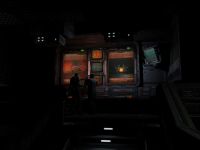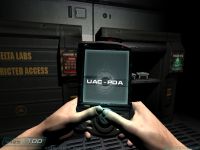|
HELL INVADES!
And so begins the most
atmospheric and immersive game I have ever played. It is there that you come
to the conclusion that, on your way and before everything went to hell
(literally), you didn’t realise how much scarier those dark corridors can be
when you toss in, say, a bunch of stumbling zombies and demons. A portal to
hell is opened and nightmares from the netherworld start to seep through. If
the quick run across the Martian surface earlier didn’t convince you, the
staggering zombies illuminated by your flashlight should: this game looks
amazing. I won’t get into the details—you’ll
just have to see it for yourself—but
you really feel the evil wave that washes across the facility. And so,
steered by Sarge, who is also struggling for survival, you have to make it
through the 26 or so levels to follow.

What kind of a videocard do you have in there?
From the beginning,
id announced that this game’s focus was to make you go through underwear
faster than you do ammo. Making a scary game is no easy business, and
whether they succeeded or not is objective. It may be scary to some (or
most) people and it may not frighten others. But if you play it in the dark,
with a powerhouse computer and surround-sound speakers (or headphones)
shaking the walls, it’s bound to get your heart racing. I know it did for
me. There were a number of times that I jumped (something usually followed
by a grisly death). Doom 3 also had a lot of ‘Oh crap!’ moments. I don’t
want to spoil any, but let me say that some cut-scenes (particularly a
pinkie-related one) definitely pushed tension to a whole new level.
Most monsters have a cut-scene
that introduces them. And although not all are scary, some really are
freaky. Scary or not, all of them are awesome and fun to watch, even if you
aren’t half-way off your chair from the edging terror. In fact, I’d say that
goes for the entire game. Even if it doesn’t register as scary in your mind,
it still looks breathtakingly cool. This is an id Software game, and that’s
all you need to know. Because that translates into cutting-edge graphics,
great design, amazing atmosphere, and extremely fun gameplay. What more
could you ever want from a game? But there is another factor that id
Software brilliantly throw in their games, and that is attention to detail.
Often included are
small things that someone may never notice, but it’s there, and it all
combines together to make the game even more tangible. Watch the monitor
screens when the invasion first takes place. Indeed, id Software pull all
the stops, with satanic glowing symbols that shoot across the walls, demonic
voices and visions, to list a few. And when you look at the level of detail
dedicated to each and every room in Doom 3, it becomes evident why this game
took around 4 years to make: wires run across the floor, issuing gas. Panels
hang from the ceiling and lay down beside the walls from where they fell;
ground panels lie out of their place, monitors hiss with static under
cracked screens, various mechanical parts hang out from openings in the
walls. Indeed, you really do feel the power of the demonic invasion that
took place, and it’s in large part due to attention to detail.
And this leads me to
another feature in this game, the interactive computer consoles scattered
about the station. This feature is really amazing. You use computer
consoles with FLASH-quality interfaces to do everything from opening an
airlock, to turning heat vents on, and in multiplayer, turning off the
lights. When you approach a console, your weapon drops and a cursor appears
on the screen, and all this is still in the game. You are looking down and
interacting with a computer in the game world. This feature is well done
(though they probably could’ve done a lot more things with it, but that’d
take even more time) and really adds to the game universe. No more do you
have simple switches and things, now fully operable in-game consoles have
come abroad, and though they’re used brilliantly in the game, I look forward
to seeing what game modifications are going to do with it.
Making good use of
the real-time shadows is the flashlight. The thing is (man, have a lot of
people been whining about this) that you can’t carry the flashlight and a
gun at the same time. This is, of course, a gameplay device that really does
work in building tension. The flashlight looks great, and I personally
enjoyed illuminating a zombie or some other demon with it, then switching to
a weapon, and having to use intuition to guess the exact position of the
zombie and shoot it out of the darkness. You can use the ‘F’ key to toggle
the flashlight. Be careful, though. Say what you will, but I used the scroll
wheel on my mouse to toggle the flashlight and, when a firefight started, I
found that pressing the ‘F’ key really didn’t do anything. Although the
flashlight can be used as a clubbing tool, I didn’t last too long in that
one instance, but it taught me one thing: never, ever bring up the
flashlight with the weapon keys or the scroll wheel.
Another thing, though
perhaps not as original, though very well made and used in the game is the
handy PDA you’re issued at the beginning of the game. I was a bit sceptical
about this feature; after all, I had waited a long time for this game, so I
didn’t feel like wasting my time reading e-mails and things on my PDA; I
just wanted to run around and start gunning down demons. However, as I
started picking up the PDAs of dead persons about the base and browsing
through their e-mails and voice recordings, my PDA started to fascinate me
and soon, I looked forward to finding other people’s PDAs. The people’s
e-mails and voice recordings really do add to the atmosphere and help
establish the larger back-story. You get to see what happened before the
invasion. And not only does it do this, but it often gives you much-needed
security clearances to proceed to the next level.

Your handy PDA--Get used to seeing this.
The e-mails are
well-written and thought out. Some are humorous (such as the explanation as
to why there are chainsaws on Mars) while others are dark with scientists or
other people from the Mars base expressing their concerns and talking about
odd events that have been going on. Often, they will list security codes for
ammunition lockers, which can be really useful if you’ve been tossing ammo
around like confetti. There is some spam and things of that sort, which I
personally didn’t think were bad, as the PC Gamer reviewer thought. In the
PC Gamer review, the game was criticised for one instance where you have to
leave the game and go on the net for a code. My guess is that this reviewer
never really went on-line to find the code, because if he had, he wouldn’t
be complaining. And although one e-mail that centres around some sort of
role-playing club was odd, out of place, and maybe a bit annoying, I’d say
that it’s the only mishap of this entire part of the game.
As with the rest of
the game, the voice recordings are well-made and believable. I really am
astounded with the voice acting in this game. You can hear people sound
uneasy, question what’s going on, describe rumours that are flying around
the Martian base with utmost realism. And along with the voice recordings,
there are also the occasional video disks that you can pick up. These play a
rather unimportant role in contrast to the other two, though they are, like
everything else, well-made and certainly worth watching. The first video you
get is an introduction to the Mars facility, followed by various forms of
propaganda for the UAC. They really do capture the spirit of what it’s like
when large corporations try to appeal to the everyday person through use of
commercials.
But soon, all this is
thrown out the window as the game takes a detour through hell. And how
amazing it is! Id really went out of their way in trying to make hell a
supremely unsettling, and different in nearly every aspect from Mars, place.
Just about every sick and scary thing you might associate with hell is in
there, and a whole lot more. I love how everything looks and feels
different, even the creatures have different skins! As if the décor around
you isn’t bad enough, you may find that you no longer have a flashlight or
weapons (well, you find a shotgun soon enough, but if you thought you were
toting little ammo before, just wait…)! I thought it a bit odd that you
would lose your weapons and flashlight when travelling between universes,
but not your PDA, but I guess from a game-design point of view, it makes
sense; you need your PDA until the end to give you mission specs. But what
pained me most was the absence of the flashlight.
The first part of the game
greatly focuses on the precious switching between weapon and flashlight. As
I wandered through hell, I kept on instinctively
pushing the ‘F’ key to bring up the flashlight, only to be disappointed when
nothing came up. And some of the areas are quite dark, too. Though I had
played that far on the standard brightness the game came with, I found
myself pushing it up because, in certain areas, all I saw was black with
little patches of glowing red here and there. That aside, hell marks a great
change in the game that keeps until the end, and it should stop anyone
whining about a change of scenery. In hell, everything is affected, even
your stamina bar! Not that I really noticed: I knew you were able to spring
with the ‘shift’ key, though as I played through the game’s tight corridors,
I never really found the need to sprint. That, and after playing Halo, even
simply walking in Doom 3 feels like I’m running.
Following Betruger
back to Mars, the story reaches its climax at the excavation sites of the
ruins of an ancient Martian civilisation (it doesn’t sound too well on
paper, trust me, it’s amazingly well done). This is just one part of Doom 3
that really makes you realise how great it really is. It really blew my mind
how long this game was; I remembered reading about hell and all these things
that happened half-way through the game. I had played the game for such a
long time, and I realised I wasn’t half-way through yet! You definitely get
a lot for your money, with over 20 hours of solid entertainment. Though this
game has been criticised for being repetitive, I think otherwise. There were
moments when I was just about to exclaim, ‘OK, this game really is
repetitive’ when I was cut short by the appearance of a new monster or
weapon. All the rooms in the Mars base were unique, though similar, though
the occasional cave or pit of toxic sludge certainly brought a change of
scenery, and all this kept me hooked until hell, from where everything is
visually mind-blowing. Every minute of those 20 hours is well-spent.
Introduction
Graphics
The beginning
Hell invades!
Multiplayer
Mishaps that you shoot
Mishaps that you shoot (cont)
Odd, ends and a verdict
|
|